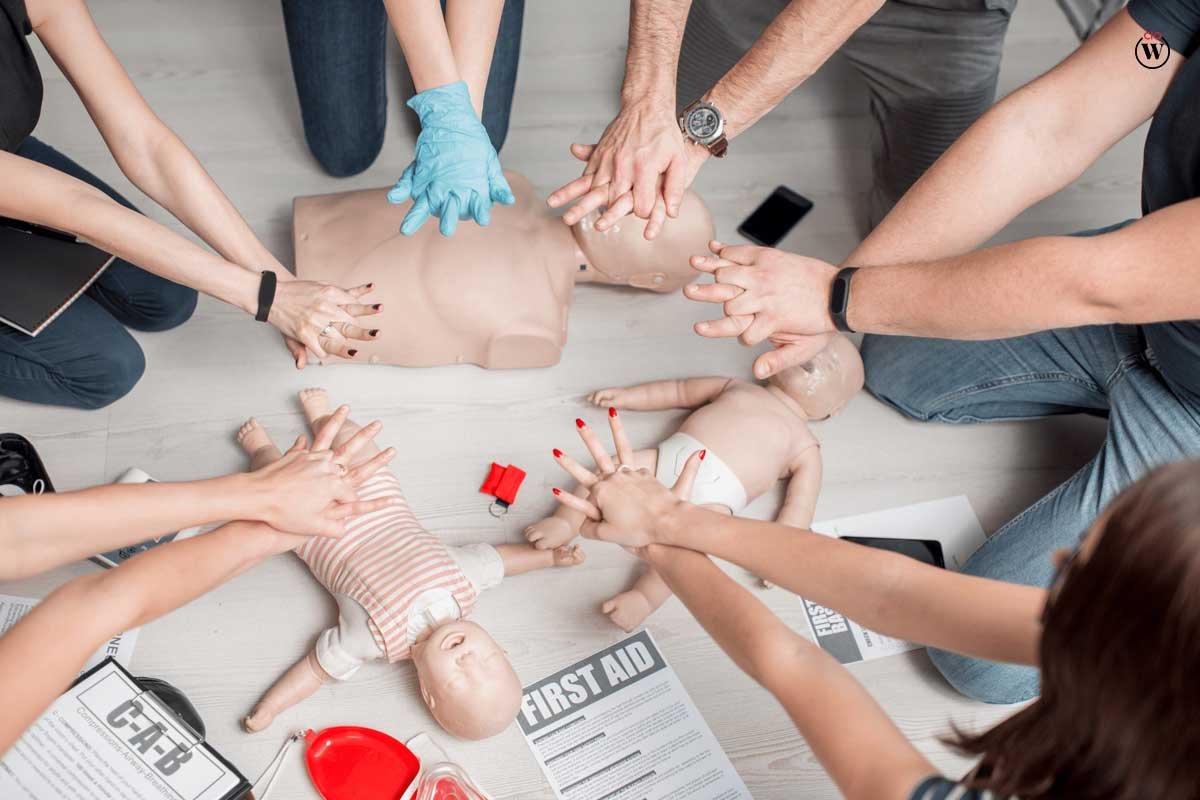Augmented reality (AR) experiences can amaze and entertain because they blur the lines between reality and fantasy. Using Virtual and Augmented Reality in Healthcare or a combination of computer-generated imagery and physical world props, augmented reality provides a truly immersive experience. AR technology has progressed into a creative tool with practical applications across a wide range of sectors, including healthcare, thanks to the development of accessible and affordable hardware and advances in the creation of photorealistic and high-quality content.
In 2018, the worldwide market for augmented reality healthcare was estimated at $609.60 million. By 2026, that number is expected to increase to $4,237.60 million. Based on these predictions, it’s clear that AR applications in healthcare aren’t a fad. Augmented reality has the potential to revolutionize working practices across the healthcare sector and ultimately improve patient outcomes in several ways, including supporting the diagnosis, and treatment of patients, and harnessing its power to educate and inform.
Here are the 12 Best Benefits of Virtual and Augmented Reality in Healthcare;
1. Aiding in the education of medical personnel
Training and developing the skills and knowledge base of future generations of medical professionals is a significant benefit of Virtual and Augmented Reality in Healthcare or the adoption of AR across the healthcare sector.
The COVID-19 pandemic has highlighted the importance of augmented reality (AR) in training medical students and may hasten the widespread adoption of AR technologies for education. Because of the spread of this highly contagious and potentially fatal virus throughout the hospital, medical students were temporarily denied direct access to ward rounds, an integral part of their education in the past.
Barts Health NHS Trust and the Queen Mary University of London took a novel approach to a critical threat to the training of future healthcare professionals in Virtual and Augmented Reality in Healthcare.

Professor Shafi Ahmed would wear a Microsoft Hololens headset while on ward rounds and high-quality content from his rounds would be live-streamed to students in a lecture hall.
That meant that students weren’t just watching the Professor’s rounds from afar, but were participating in them, seeing patients through the Professor’s eyes. Reality enhancement, Students were able to acquire a more hands-on education as a result of this, seeing actual patients and having firsthand experience with diagnostic procedures including X-rays and CT scans is part of Virtual and Augmented Reality in Healthcare.
The use of immersive and exponential technologies represents a paradigm change in the delivery of successful medical education, as Professor Ahmed explains: “My work over the past six years at Queen Mary utilizing Google Glass, virtual reality, holograms, avatars, and mixed reality has revealed.”
2. a surgical aid that helps doctors out
The first augmented reality (AR) guided surgery was done in February 2020 at the Sant’Orsola hospital in Bologna, using technology such as Microsoft Hololens to aid and speed up surgical processes. While operating to resect and reposition the patient’s upper jaw to restore the patient’s biting function, lead surgeon Giovanni Badiali used an augmented reality headset to access vital real-time patient data such as heart rate, body temperature, blood pressure, and breathing rate, in addition to pre-operative images from CT, MRI, and 3DUS scans.
In surgical operations, when every second counts, the ability to quickly retrieve patient data is crucial for the widespread use of augmented reality. As Giovanni Badiali puts it, “We are on the verge of a medical revolution in terms of surgical navigation… Eventually, we may be able to collaborate without any hitches. When used to surgical procedures, this implies less time spent connecting the dots between the virtual world and the real world and more time spent performing the procedures. Every piece of data is received instantly. This technology has the biggest positive impact on time in Virtual and Augmented Reality in Healthcare.
3. locating veins
Nurses and physicians have also started using AR to better spot veins. This solves the problem that many patients find it traumatic and painful to have blood taken and that many doctors find it problematic to collect blood from their patients due to difficulties identifying a vein, particularly in those with dark skin or tiny arteries in Virtual and Augmented Reality in Healthcare.
Technology powered by augmented reality, such as Accuvein, may be used to solve these problems. The technology in question is a handheld device that incorporates a laser-based scanner, processing system, and digital laser projection. This provides medical professionals with a unique opportunity to see the dermal vasculature in real-time using a computer-generated simulation. This allows for improved vein detection and facilitates the administration of intravenous injections with less patient pain.
4. Boosting the Quality of Consultations with Patients
The application of augmented reality in the healthcare industry may be beneficial not only to healthcare workers but also to patients. It is becoming more apparent that the use of immersive technology like augmented and Virtual and Augmented Reality in Healthcare reality may improve learning processes, particularly when it comes to helping patients gain a deeper comprehension of their medical issues. Supporting patient consultations using augmented reality allows patients to learn more about their conditions and treatment options.
“providing someone the capacity to instantaneously see an illness or condition on their skin, or allowing them to experience what someone with — say, macular degeneration — sees is more significant than other types of visual and textual representation,” said Yan Fossat, vice president of Klick Labs at Klick Health.
5. Using augmented reality 3D body scanning to improve medical care
X-rays and CT scans are examples of imaging technologies that rely heavily on visuals and are widely used in the medical field. Simply said, they aid in the detection, diagnosis, and treatment of patients by allowing doctors to view their bodies in Virtual and Augmented Reality in Healthcare.
This is where augmented reality comes in, building on top of what already exists. As a result, professionals may be able to view and examine precise and lifelike 3D photos using augmented reality devices like Microsoft Hololens. That may speed up diagnosis and enhance treatment.
6. Increased Efficiency in Diagnosis and Treatment
Through the use of augmented reality, we may create a simulation of the patient’s symptoms. As a result, the doctor will have an easier time making diagnoses and settling on a course of therapy in Virtual and Augmented Reality in Healthcare.

Through the use of augmented reality (AR), it is possible to recreate the symptoms of a patient’s eye condition. The doctor will be able to examine the situation in further detail and provide solutions.
7. Improved Patient Experience and Involvement
Augmented reality’s ability to boost consumer happiness and engagement with hospital apps is a major benefit in the healthcare sector. For instance, augmented reality (AR) experiences in applications for mental or physical rehabilitation significantly increase user engagement during training in Virtual and Augmented Reality in Healthcare.
To summarize, augmented reality in healthcare improves our quality of life and opens up exciting new possibilities for cutting-edge technology and future medicine.
8. Care for Mental Illness
First, virtual reality is quickly replacing traditional methods of treating mental health issues like PTSD. For instance, it is now being used to aid military personnel in coping with the psychological effects of battle in Virtual and Augmented Reality in Healthcare.
9. Intensifying the level of sophistication used to describe health problems
It’s no secret that patients have trouble giving clear descriptions of their symptoms while seeking medical care. On top of that, people may have negative emotional responses to a medical crisis, such as anger or fear. Here’s where augmented reality may assist streamline the previous procedure in Virtual and Augmented Reality in Healthcare.
For instance, the EyeDecide app makes use of a camera that enables clinicians to see the eyeball from any angle to mimic the effects of various disorders on the eye’s health and eyesight. This software also offers a unique chance to show the effects of age-related macular degeneration (AMD) and cataracts on human eyes in real-time. Patients are better able to understand their condition and the options available to them thanks to the augmented reality solution, and they are more likely to take steps to improve their eye health as a result.
10. Assess Vision Needs With AR Technology
Indeed, many of the tiniest blood arteries may be found in the eyes, and there is no way for physicians to identify them by feeling alone. Technology like augmented reality has made this obsolete. It will provide optometrists with a better view of the eyes for examination, and this will lead to a more accurate diagnosis.
In addition, Virtual and Augmented Reality in Healthcare, AR-enabled technologies allow optometry doctors to precisely describe the ailment and how it may be cured. Patients, for instance, may use augmented reality software to virtually experiment on several eyeglass frames before making a final purchase decision.
11. Augmented reality aids in dental disease detection.
Dentists in today’s digital environment may take use of AR’s potential to address issues like cavity prevention and overall oral health improvement. You may already be aware that many dental offices use 3D digital scans to assist diagnose oral health concerns. AR-enabled glasses allow dentists to quickly detect an infection or precisely measure the cavity depth before filling it in Virtual and Augmented Reality in Healthcare.
Dental doctors may also benefit from the use of AR-based equipment when fabricating crowns or implants. It’s quite similar to the prosthetic limbs that physicians of all sizes and complexities have created. Dental students and/or helpers might benefit from this method for learning whether or not a patient feels at ease with a certain dental appliance. Teachers may create interactive 3D virtual representations of dental problems for their pupils to inspect and experience using augmented reality software.
12. Better Doctor-Patient Communication with Augmented Reality
According to a recent poll, some people want healthcare professionals to employ novel solutions to give a one-of-a-kind experience for them, while others want more fact-based consultations from their physicians. In conclusion, augmented reality (AR)-enabled solutions may give the accurate data patients want while also allowing for increased utilization of cutting-edge technology like Virtual and Augmented Reality in Healthcare.

Relationships between patients and doctors may be elevated to new heights with the help of augmented reality software. These developments will allow for more precise diagnosis, quicker patient involvement, and individualized care. In addition, it’s a fantastic tool for helping patients learn more about their ailments, treatments, or forthcoming procedures like Virtual and Augmented Reality in Healthcare.









